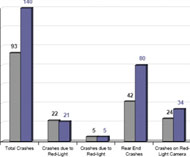Article from: www.thenewspaper.com/news/20/2023.asp
10/18/2007
Lubbock, Texas Red Light Cameras Increase Accidents
The total number of accidents jumped fifty percent at intersections using red light cameras in Lubbock, Texas.
 A preliminary report released Tuesday showed that red light cameras have provided no immediate safety benefit in Lubbock, Texas. At the twelve intersections using automated ticketing machines, rear end crashes nearly doubled and the total number of crashes jumped 50 percent, according to the program's first quarterly review. Intersections without cameras saw a less dramatic increase in accidents. The numbers compared results from July 1 through September 30 of this year to the same period last year.
A preliminary report released Tuesday showed that red light cameras have provided no immediate safety benefit in Lubbock, Texas. At the twelve intersections using automated ticketing machines, rear end crashes nearly doubled and the total number of crashes jumped 50 percent, according to the program's first quarterly review. Intersections without cameras saw a less dramatic increase in accidents. The numbers compared results from July 1 through September 30 of this year to the same period last year.
"We simply have not had enough time to get meaningful results," Public Works Director Marsha Read said. "Three months really is not a good comparison statistically."
Despite the negative initial figures, officials praised the program and claimed a reduction in the number of injuries reported from 28 to 22 was a sign the program has been working. The total injury figure does not necessarily represent a reduction in injury accidents. It is equally likely to reflect a reduction in the number of passengers in vehicles involved in an injury accident. Independent studies examining several years' worth of data in other cities have documented an increase in both injury and property damage collisions where red light cameras are used. View a chart showing Lubbock's results obtained by Robert Pratt of KFYO radio.
Lubbock's ticketing effort has been mired in scandal since it began in July.
ATS, the private company in charge of the ticketing program, selected high-volume intersections with short yellow times for the first set of cameras. It did so after a review of the intersections with the highest accident rates determined they would not generate sufficient profit for the company. According to city documents, City Engineer Jere Hart promised not to lengthen the yellow warning time at intersections, as recommended by the Texas Transportation Institute.
"If implemented, the public would prefer to have an increased amber cycle, but [Jere Hart with Traffic Engineering] stated the program will not adjust the amber/yellow time," the minutes of a traffic committee meeting last September stated.
Controversy erupted in February when local television station KCBD documented the short yellow times, including one intersection with a 2.9 second timing, below the minimum required under federal law. The revelation delayed the program so long that the city, depending on $2 million in expected ticket profit, was forced to impose a hiring freeze to maintain solvency.
 A preliminary report released Tuesday showed that red light cameras have provided no immediate safety benefit in Lubbock, Texas. At the twelve intersections using automated ticketing machines, rear end crashes nearly doubled and the total number of crashes jumped 50 percent, according to the program's first quarterly review. Intersections without cameras saw a less dramatic increase in accidents. The numbers compared results from July 1 through September 30 of this year to the same period last year.
A preliminary report released Tuesday showed that red light cameras have provided no immediate safety benefit in Lubbock, Texas. At the twelve intersections using automated ticketing machines, rear end crashes nearly doubled and the total number of crashes jumped 50 percent, according to the program's first quarterly review. Intersections without cameras saw a less dramatic increase in accidents. The numbers compared results from July 1 through September 30 of this year to the same period last year.